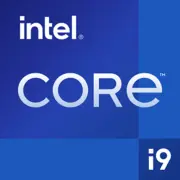Intel Core i9-12900T

Intel Core i9-12900T: Power and Efficiency in a Compact Package
March 2025
1. Key Specifications: Architecture, Process Technology, Performance
Hybrid Alder Lake Architecture
The Intel Core i9-12900T is a flagship processor featuring the hybrid Alder Lake architecture, which combines 16 cores (8 Performance-cores and 8 Efficient-cores) and 24 threads. P-cores (Performance) are responsible for high single-thread performance, while E-cores (Efficient) optimize multi-threaded tasks and power consumption. The Intel 7 process technology (10 nm Enhanced SuperFin) provides a balance between power and efficiency.
Frequencies and Cache
- Base Frequency P-cores: 1.40 GHz (in power-saving mode).
- Maximum Turbo Frequency P-cores: 4.80 GHz.
- L3 Cache: 30 MB (shared among all cores).
Despite a low TDP of 35 W, the processor shows impressive performance:
- Geekbench 6: 2331 (single-core), 12116 (multi-core).
In comparison, this performance level rivals top desktop CPUs from previous generations, but with half the power consumption.
Key Technologies
- Intel Thread Director: Optimizes task distribution between P- and E-cores, especially in Windows 11.
- Support for DDR5 and PCIe 5.0: Bandwidth of up to 4800 MT/s (DDR5) and 128 GB/s per PCIe 5.0 lane.
- Intel UHD Graphics 770: 32 execution units, supporting 4K@60 Hz and AV1 decoding.
2. Compatible Motherboards
LGA 1700 Socket and Chipsets
The processor uses the LGA 1700 socket and is compatible with the following chipsets:
- Z690/H670/B660/H610 (for desktops).
- W680 (workstations).
Selection Recommendations:
- Z690/H670: For maximum performance (PCIe 5.0, RAM overclocking). Example: ASUS ROG Strix Z690-A Gaming WiFi ($250–$300).
- B660: Budget-friendly option with DDR5 support. Example: MSI MAG B660 Tomahawk ($150–$180).
- Mini-PC and NUC: H610-based boards are suitable for compact builds.
Important: Not all boards support DDR5 — check the specifications.
3. Supported Memory: DDR4 vs DDR5
The processor works with DDR4-3200 and DDR5-4800, but the choice depends on the motherboard.
Comparison:
- DDR4: Cheaper (32 GB kit — $80), stable, but lower bandwidth.
- DDR5: More expensive (32 GB kit — $150), higher speed and energy efficiency, future upgrade potential.
Tip: For work tasks (rendering, virtualization), choose DDR5. For office PCs, DDR4 is sufficient.
4. Power Supply: Calculation and Recommendations
With a TDP of 35 W, the processor is modest in power consumption, but consider discrete graphics cards and peripherals:
- Minimum: 500 W (for systems with NVIDIA RTX 4060 level GPU).
- Recommended: PSUs with an 80+ Gold certification (stability + 90% efficiency). Examples:
- Corsair RM550x ($90).
- Seasonic FOCUS GX-550 ($85).
For compact builds without discrete graphics, a 300 W PSU is sufficient (e.g., be quiet! SFX Power 3 350W).
5. Pros and Cons of the i9-12900T
Pros:
- High performance with low TDP.
- Support for DDR5 and PCIe 5.0 (future-proofing).
- Integrated graphics for basic tasks.
Cons:
- Price ($450–$500) is higher than AMD counterparts.
- Requires efficient cooling under load.
- DDR5 is still expensive (but prices are dropping by 2025).
6. Use Cases
Gaming
- With a discrete graphics card (e.g., RTX 4070): 4K@60+ FPS in AAA titles.
- With UHD 770: CS2, Dota 2 at medium settings (1080p).
Work Tasks
- Rendering (Blender, Maya): 30% faster than i9-11900K thanks to 24 threads.
- Programming: 15–20% faster compilation in Visual Studio.
Multimedia
- Streaming (OBS + AV1 encoding).
- 8K video editing in DaVinci Resolve.
7. Comparison with Competitors
- AMD Ryzen 9 7900 (65 W): Higher multi-threaded performance (~13500 in Geekbench 6), but more expensive ($550) and 65 W TDP.
- Apple M3 Max: Better energy efficiency, but limited macOS ecosystem.
- Intel Core i7-12700T: 20% cheaper ($350), but fewer cores (12/20).
Conclusion: The i9-12900T is optimal for Windows systems where a balance of power and energy savings is important.
8. Practical Assembly Tips
1. Cooling: Even with a TDP of 35 W, under load, you need a cooler like Noctua NH-U12S ($70) or AIO (NZXT Kraken X53).
2. Memory: For DDR5, choose modules with heatsinks (e.g., Kingston Fury Beast 32 GB).
3. BIOS: Update to the latest version for compatibility with Alder Lake.
4. Case: Fractal Design Node 304 is suitable for mini-PCs; for gaming, Lian Li O11 Dynamic is recommended.
9. Final Verdict: Who is the i9-12900T For?
This processor is ideal for:
- Compact workstations (video editing, 3D modeling).
- Energy-efficient PCs (home servers, media centers).
- Gamers who prefer quiet systems with discrete graphics.
Why choose it? Its hybrid architecture, support for DDR5/PCIe 5.0, and low power consumption make it a versatile solution in 2025. However, if budget is a concern, consider the i7-12700T or AMD Ryzen 7 7700.
Prices are accurate as of March 2025. Check with local retailers for updates.
Basic
CPU Specifications
Memory Specifications
GPU Specifications
Miscellaneous
Benchmarks
Compared to Other CPU
Share in social media
Or Link To Us
<a href="https://cputronic.com/cpu/intel-core-i9-12900t" target="_blank">Intel Core i9-12900T</a>